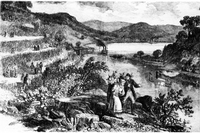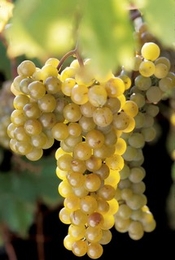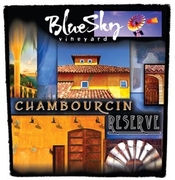Discussions of United States wines tend to focus on California first, with Oregon and Washington completing the west coast triumvirate. California leads the way with 4000+ wineries and both Oregon and Washington contain hundreds of wine estates. It’s not nearly as well known that Missouri, Pennsylvania, Colorado, Michigan, Ohio, Virginia, Texas, Illinois and North Carolina all boast over 100 wineries within their borders.
Although there is a long viticultural history in this country, the vinous slate was wiped virtually clean by the 13 years of Prohibition between 1920 and 1933. Even after repeal, however, the nation was in the throes of the Great Depression, followed by World War II and the postwar recovery. It was not until the mid 1960’s that a new wine industry began.
A recent tabulation shows that there are 10,472 wineries in the United States, a 69% increase from the 6357 wineries in 2009 and a long, long way from the 441 wineries in 1970. Even outside of California, Oregon and Washington, there are 4,238 wineries. The growth in the number of winemaking establishments is quite dramatic. Thus, there are more and more places a wine-loving tourist can visit.

The heartland of the United States was once the heart of the wine industry as well. In 1860, before diseases attacked the vineyards, Ohio vineyards produced the equivalent of a quarter million cases of wine, more than a third of the national production at that time. Today, you’ll find vines growing throughout the heartland — from the Great Lakes states of Michigan and Wisconsin to the Ozarks of Missouri and Arkansas to the fertile hills and flatlands of Indiana, Illinois, and throughout Iowa, Kansas and Nebraska.
If you are visiting wineries in the heartland, however, you may come across some unfamiliar grape varieties. The genus Vitis encompasses some 79 species of vining plants. The Vitis vinifera species is the best known to wine lovers because Vitis vinifera varieties encompass the famous names of Cabernet Sauvignon, Chardonnay, Merlot, Pinot Noir and more. Most Vitis vinifera vines, however, cannot survive temperatures lower than zero degrees Fahrenheit. That becomes a survival issue in much of the central US, where winter temperatures frequently drop to below zero. Hence, there has been a great deal of work done to develop cold-hardy varieties that can both produce fine wine grapes and survive a cold winter.

University of Minnesota Research Vineyard
Grape breeding programs at the University of Minnesota and Cornell University have bred varieties in recent decades that can fulfill the need for sustainable grape varieties. Complex crossings of native American species like Vitis Riparia and Vitis labrusca with Vitis vinifera varieties have had good results. Hybrid grape varieties like the white La Crescent and the reds Marquette and Frontenac have been released by the University of Minnesota. The Cornell grape breeding program has released the whites Traminette and Chardonel and the reds Noiret and Corot Noir among others. Earlier-bred hybrids like Norton/Cynthiana, Baco Noir, Chambourcin, Chancellor, Marechal Foch and Seyval Blanc are all found in northern vineyards as well.
I have had an opportunity to evaluate many hybrid-based wines both in my travels and in wine judgings. Over the past decade, the quality of hybrid wines has increased dramatically as vintners learn the best way to grow and vinify their grapes. Many of the new grape varieties have only been released in the last two decades. It takes a few years for the vines to become productive and a few more to discern where they might thrive in any vineyard.

La Crescent has Muscat as part of its complex genealogy and has a floral freshness to it. Released in 2002, it has proven to be a versatile grape and I have sampled excellent renditions in both a dry and off-dry style. The Illinois Sparkling Wine Company makes a methode traditionelle sparkling wine from Illinois La Crescent grapes called Sec. I have also tried fine still La Crescent wines from diverse wineries like Flag Hill Winery in New Hampshire, Elmaro Vineyard in Wisconsin, Tug Hill Vineyards in New York and Parley Lake Winery in Minnesota. Similarly, a search of white wines from heartland wineries can yield delicious examples of Seyval Blanc, Traminette, Vidal, Brianna and Vignoles.
Chambourcin is a promising red hybrid. It was bred in France and released in 1945. Unlike most wine grapes which have white juice, its juice has a pale red color. The resultant wines can be quite deeply colored. It has been planted in many areas in the United States with success. I have enjoyed excellent examples from Holy-Field Winery in Kansas, Blue Sky Vineyard in Illinois, Augusta Winery and Noboleis Vineyards in Missouri. Among other red wines, Marquette wines from Wisconsin, Iowa, Montana and Minnesota have all shown well in wine competitions.

There are some places where classic Vitis vinifera vines can survive and thrive. Often there is a lake or river that moderates the climate and keeps the killing cold at bay. Northern Michigan is noted for fine wines from the Leelanau and Old Mission Peninsulas that extend into the lake north of Traverse City. Sparkling wines from the L. Mawby winery are highly regarded. I have sampled especially fine Rieslings from Bowers Harbor and Left Foot Charley wineries, and there are many more to sample. In New York’s Finger Lakes, the moderating influence of the lakes allows vinifera varieties to survive the winters. I have enjoyed exceptional Rieslings from Fox Run Vineyards, Boundary Breaks and Keuka Lake Vineyards, among others. While Riesling gets most of the glory, other grapes – both red and white, vinifera as well as hybrids – are yielding fine wines in these areas as well.
Wherever you may roam in the months to come, it’s likely there is a winery to explore. Go with an open mind and try something you’ve never had before. You may find a new favorite to add to your repertoire.
